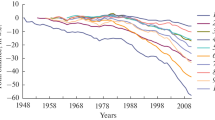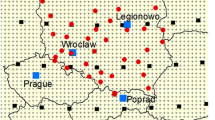Abstract
The problem of preparing initial climatic data with varying frequency of occurrence for thermodynamic modeling of Arctic ice is considered. It is revealed that air temperature is the most significant meteorological parameter for such calculations. Based on the estimation of the sum of freezing degree-days for the cold season, a method for preparing initial data for the thermodynamic calculation of parameters of growing ice of rare occurrence is presented. The test calculations performed for the areas with long-term series of field observations demonstrated a good agreement between the calculated and measured ice thickness both for the medium and extreme climatic conditions. It is stated that similar calculations of ice parameters can be carried out almost for any region of the Arctic.

Similar content being viewed by others
REFERENCES
O. M. Andreev and B. V. Ivanov, “Parameterization of Radiation Processes in the Ice-cover Model,” Meteorol. Gidrol., No. 2 (2001) [Russ. Meteorol. Hydrol., No. 2 (2001)].
V. P. Gavrilo, S. M. Kovalev, and O. A. Nedoshivin, Calculated Average Long-term Characteristics of Mechanical Properties of First-year Ice in the Barents and Kara Seas. Reference Book (Gidrometeoizdat, St. Petersburg, 1996) [in Russian].
E. Gumbel, Statistics of Extremes (Mir, Moscow, 1965) [Transl. from English].
WMO Guidelines on the Calculation of Climate Normals, WMO-No. 1203 (WMO, 2017) [Transl. from English].
Sea Ice. Reference Book, Ed. by I. E. Frolov and V. P. Gavrilo (Gidrometeoizdat, St. Petersburg, 1997) [in Russian].
Manual on the Global Observing System, Vol. 1: Global Aspects (Annex V to the WMO Technical Regulations), WMO-No. 544 (WMO, 2010) [Transl. from English].
WMO Recommendation on the Calculation of Climate Normals, https://meteoinfo.ru/news/1-2009-10-01-09-03-06/11151-03062015-l-r [in Russian].
V. A. Romantsov, L. Yu. Vasil’ev, and D. A. Kozelov, “The State and Development of the Observation Network in the Arctic at the Stage of IPY 2007/2008,” in Meteorological and Geophysical Studies (Paulsen, Moscow, 2011) [in Russian].
SP 38.13330.2012 “Loads and Impacts on Hydraulic Structures (Wave, Ice, Shipborne Ones). Actualized Edition of SNiP 2.06.04-82” (Moscow, 2012) [in Russian].
E. E. Ebert and J. A. Curry, “An Intermediate One-dimensional Thermodynamic Sea Ice Model for Investigating Ice–Atmosphere Interactions,” J. Geophys. Res., No. C6, 98 (1993).
European Centre for Medium-Range Weather Forecasts, https://www.ecmwf.int/.
National Centers for Environmental Prediction, https://www.ncep.noaa.gov/.
Petroleum and Natural Gas Industries–Arctic Offshore Structures. ISO/FDIS 19906: 2010 (E) (2010).
Author information
Authors and Affiliations
Corresponding author
Additional information
Russian Text ©The Author(s), 2020, published in Meteorologiya i Gidrologiya, 2020, No. 10, pp. 112-120.
About this article
Cite this article
Andreev, O.M., Drabenko, D.V. Preparation of Initial Data for the Thermodynamic Modeling of Arctic Ice. Russ. Meteorol. Hydrol. 45, 742–747 (2020). https://doi.org/10.3103/S106837392010009X
Received:
Revised:
Accepted:
Published:
Issue Date:
DOI: https://doi.org/10.3103/S106837392010009X




